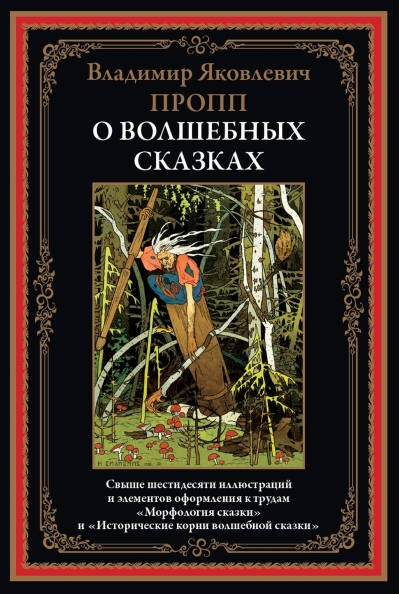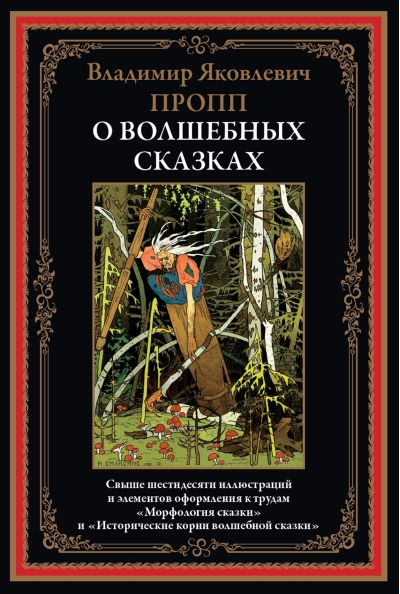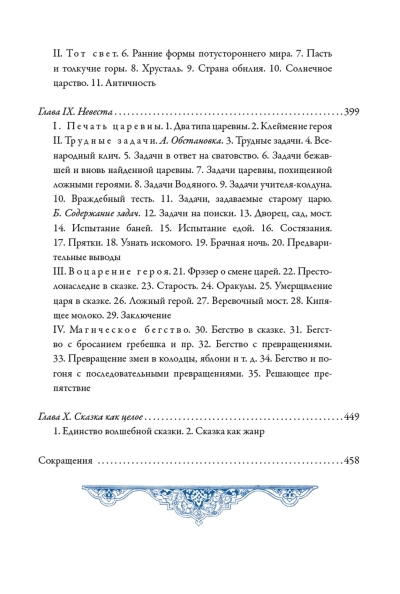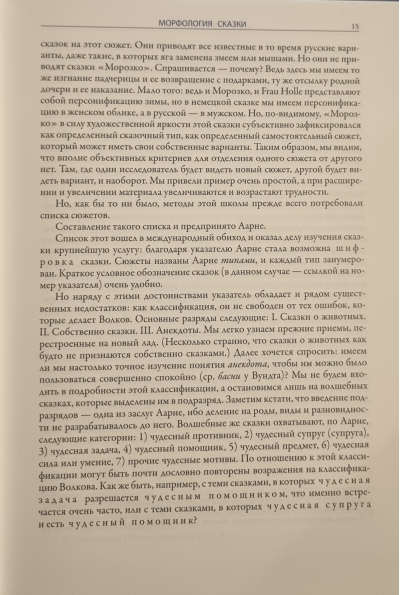About fairy tales
29.99 €
Out of stock
Vladimir Yakovlevich Propp (1895–1970), a Soviet philologist, folklorist, and one of the founders of modern text theory, was born in St. Petersburg to a family of Volga Germans. In 1913–1918, he studied first German and then Russian philology at the Faculty of Philology at Petrograd University, subsequently taught German at Leningrad universities, and from 1932 taught and conducted research at Leningrad University (LSU). From 1938, he was a professor at the Faculty of Philology at LSU, first in the departments of Romano-Germanic Philology, Folklore, and, until 1969, Russian Literature; in 1963–1964, he headed the department. This collection includes two books by Vladimir Yakovlevich - "Morphology of the Fairy Tale" (1928) and its sequel "Historical Roots of the Magic Fairy Tale" (1946).
""Morphology" and "Historical Roots" are like two parts or two volumes of one large work. The second directly follows from the first, the first is a prerequisite for the second. <…> As strictly as possible, methodically and consistently, I move from a scientific description of phenomena and facts to an explanation of their historical causes."
"Morphology of the Fairy Tale" is the scientist's most famous work; it is a monograph devoted to the structure of folk tales. Studying folklore, the scientist identified constant and variable elements in fairy tales. He classified the actions that the characters performed to develop the plot and their sequence as constants. He classified the linguistic style of the works, the number of actions and the methods of their execution, as well as the motivations and attributes of the characters as variables. The scientist's doctoral dissertation was the manuscript of the book "Historical Roots of the Fairy Tale" - a continuation of the previous monograph, which develops a hypothesis developed by the French expert on folklore Pierre Sentive (pseudonym of Emile Nourry, 1870-1935). In this work, Propp wrote not about the structure of fairy tales, but about their origins. He studied the mythology of primitive peoples and explained the origins of the fairy tale in tribal initiation rites: their participants also underwent tests, sometimes failed, then successfully completed the tasks and received a "new look". Thus, the plot of any fairy tale was explained by the initiation rite, during which children received a new status. This book is decorated with 70 illustrations and design elements by artists Ivan Yakovlevich Bilibin (1876–1942), Alexander Zik (1845–1907), Ivan Konstantinovich Lebedev (1884–1972), Nikolai Nikolaevich Popov (1888–1953), Mohammed Rasim (1896–1975), and Nikolai Alekseevich Ushin (1898–1942).
""Morphology" and "Historical Roots" are like two parts or two volumes of one large work. The second directly follows from the first, the first is a prerequisite for the second. <…> As strictly as possible, methodically and consistently, I move from a scientific description of phenomena and facts to an explanation of their historical causes."
"Morphology of the Fairy Tale" is the scientist's most famous work; it is a monograph devoted to the structure of folk tales. Studying folklore, the scientist identified constant and variable elements in fairy tales. He classified the actions that the characters performed to develop the plot and their sequence as constants. He classified the linguistic style of the works, the number of actions and the methods of their execution, as well as the motivations and attributes of the characters as variables. The scientist's doctoral dissertation was the manuscript of the book "Historical Roots of the Fairy Tale" - a continuation of the previous monograph, which develops a hypothesis developed by the French expert on folklore Pierre Sentive (pseudonym of Emile Nourry, 1870-1935). In this work, Propp wrote not about the structure of fairy tales, but about their origins. He studied the mythology of primitive peoples and explained the origins of the fairy tale in tribal initiation rites: their participants also underwent tests, sometimes failed, then successfully completed the tasks and received a "new look". Thus, the plot of any fairy tale was explained by the initiation rite, during which children received a new status. This book is decorated with 70 illustrations and design elements by artists Ivan Yakovlevich Bilibin (1876–1942), Alexander Zik (1845–1907), Ivan Konstantinovich Lebedev (1884–1972), Nikolai Nikolaevich Popov (1888–1953), Mohammed Rasim (1896–1975), and Nikolai Alekseevich Ushin (1898–1942).
See also:
- All books by the publisher
- All books by the author
- All books in the series Library of World Literature























